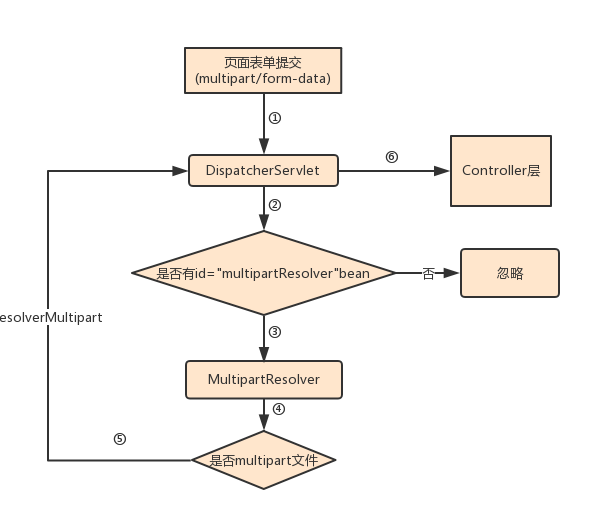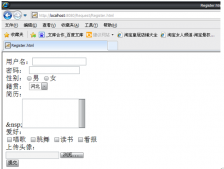首先我們要知道什么是Spring Boot,這里簡單說一下,Spring Boot可以看作是一個框架中的框架--->集成了各種框架,像security、jpa、data、cloud等等,它無須關(guān)心配置可以快速啟動開發(fā),有興趣可以了解下自動化配置實現(xiàn)原理,本質(zhì)上是 spring 4.0的條件化配置實現(xiàn),深拋下注解,就會看到了。
說Spring Boot 文件上傳原理 其實就是Spring MVC,因為這部分工作是Spring MVC做的而不是Spring Boot,那么,SpringMVC又是怎么處理文件上傳這個過程的呢?
圖:

首先項目啟動相關(guān)配置,再執(zhí)行上述第二步的時候 DispatcherServlet會去查找id為multipartResolver的Bean,在配置中看到Bean指向的是CommonsMultipartResolve,其中實現(xiàn)了MultipartResolver接口。
第四步驟這里會判斷是否multipart文件即isMultipart方法,返回true:就會調(diào)用 multipartResolver 方法,傳遞HttpServletRequest會返回一個MultipartHttpServletRequest對象,再有DispatcherServlet進行處理到Controller層;返回false:會忽略掉,繼續(xù)傳遞HttpServletRequest。
在MVC中需要在配置文件webApplicationContext.xml中配置 如下:
|
1
2
3
4
5
|
<bean id="multipartResolver" class="org.springframework.web.multipart.commons.CommonsMultipartResolver"> <property name="defaultEncoding" value="UTF-8"/> <property name="maxUploadSize" value="100000000"/> <property name="uploadTempDir" value="fileUpload/temp"/></bean> |
而Spring Boot已經(jīng)自動配置好,直接用就行,做個test沒什么問題。有默認(rèn)的上傳限制大小,不過在實際開發(fā)中我們還是做一些配置的,
如下在application.properties中:
|
1
2
3
4
5
6
7
8
9
|
# multipart config#默認(rèn)支持文件上傳spring.http.multipart.enabled=true#文件上傳目錄spring.http.multipart.location=/tmp/xunwu/images/#最大支持文件大小spring.http.multipart.max-file-size=4Mb#最大支持請求大小spring.http.multipart.max-request-size=20MB |
當(dāng)然也可以寫配置類來實現(xiàn),具體的就不做展示了。
看完上述你肯定有個大概的了解了,這里再啰嗦下,Spring提供Multipart的解析器:MultipartResolver,上述說的是CommonsMultipartResolver,它是基于Commons File Upload第三方來實現(xiàn),這也是在Servlet3.0之前的東西,3.0+之后也可以不需要依賴第三方庫,可以用StandardServletMultipartResolver,同樣也是實現(xiàn)了MultipartResolver接口,我們可以看下它的實現(xiàn):
|
1
2
3
4
5
6
7
8
9
10
11
12
13
14
15
16
17
18
19
20
21
22
23
24
25
26
27
28
29
30
31
32
33
34
35
36
37
38
39
40
41
42
43
44
45
46
47
48
49
50
51
52
53
54
55
56
57
58
59
60
61
62
63
64
65
66
67
68
69
70
71
|
* Copyright 2002-2017 the original author or authors.package org.springframework.web.multipart.support;import javax.servlet.http.HttpServletRequest;import javax.servlet.http.Part;import org.apache.commons.logging.LogFactory;import org.springframework.web.multipart.MultipartException;import org.springframework.web.multipart.MultipartHttpServletRequest;import org.springframework.web.multipart.MultipartResolver;/** * Standard implementation of the {@link MultipartResolver} interface, * based on the Servlet 3.0 {@link javax.servlet.http.Part} API. * To be added as "multipartResolver" bean to a Spring DispatcherServlet context, * without any extra configuration at the bean level (see below). * * <p><b>Note:</b> In order to use Servlet 3.0 based multipart parsing, * you need to mark the affected servlet with a "multipart-config" section in * {@code web.xml}, or with a {@link javax.servlet.MultipartConfigElement} * in programmatic servlet registration, or (in case of a custom servlet class) * possibly with a {@link javax.servlet.annotation.MultipartConfig} annotation * on your servlet class. Configuration settings such as maximum sizes or * storage locations need to be applied at that servlet registration level; * Servlet 3.0 does not allow for them to be set at the MultipartResolver level. * * @author Juergen Hoeller * @since 3.1 * @see #setResolveLazily * @see HttpServletRequest#getParts() * @see org.springframework.web.multipart.commons.CommonsMultipartResolver */public class StandardServletMultipartResolver implements MultipartResolver { private boolean resolveLazily = false; /** * Set whether to resolve the multipart request lazily at the time of * file or parameter access. * <p>Default is "false", resolving the multipart elements immediately, throwing * corresponding exceptions at the time of the {@link #resolveMultipart} call. * Switch this to "true" for lazy multipart parsing, throwing parse exceptions * once the application attempts to obtain multipart files or parameters. */ public void setResolveLazily(boolean resolveLazily) { this.resolveLazily = resolveLazily; } @Override public boolean isMultipart(HttpServletRequest request) { // Same check as in Commons FileUpload... if (!"post".equals(request.getMethod().toLowerCase())) { return false; } String contentType = request.getContentType(); return (contentType != null && contentType.toLowerCase().startsWith("multipart/")); } @Override public MultipartHttpServletRequest resolveMultipart(HttpServletRequest request) throws MultipartException { return new StandardMultipartHttpServletRequest(request, this.resolveLazily); } @Override public void cleanupMultipart(MultipartHttpServletRequest request) { // To be on the safe side: explicitly delete the parts, // but only actual file parts (for Resin compatibility) try { for (Part part : request.getParts()) { if (request.getFile(part.getName()) != null) { part.delete(); } } } catch (Throwable ex) { LogFactory.getLog(getClass()).warn("Failed to perform cleanup of multipart items", ex); } }} |
這里是之前寫的test的后者實現(xiàn)配置類,可以簡單看下,作為了解:
|
1
2
3
4
5
6
7
8
9
10
11
12
13
14
15
16
17
18
19
20
21
22
23
24
25
26
27
28
29
30
31
32
33
34
35
36
37
38
|
package com.bj.config;import org.springframework.boot.autoconfigure.condition.ConditionalOnMissingBean;import org.springframework.boot.autoconfigure.web.MultipartProperties;import org.springframework.boot.context.properties.EnableConfigurationProperties;import org.springframework.context.annotation.Bean;import org.springframework.context.annotation.Configuration;import org.springframework.web.multipart.MultipartResolver;import org.springframework.web.multipart.support.StandardServletMultipartResolver;import org.springframework.web.servlet.DispatcherServlet;import javax.servlet.MultipartConfigElement;@Configuration@EnableConfigurationProperties(MultipartProperties.class)public class FileUploadConfig { private final MultipartProperties multipartProperties; public FileUploadConfig(MultipartProperties multipartProperties){ this.multipartProperties=multipartProperties; } /** * 注冊解析器 * @return */ @Bean(name= DispatcherServlet.MULTIPART_RESOLVER_BEAN_NAME) @ConditionalOnMissingBean(MultipartResolver.class) public StandardServletMultipartResolver multipartResolver(){ StandardServletMultipartResolver multipartResolver = new StandardServletMultipartResolver(); multipartResolver.setResolveLazily(multipartProperties.isResolveLazily()); return multipartResolver; } /** * 上傳配置 * @return */ @Bean @ConditionalOnMissingBean public MultipartConfigElement multipartConfigElement(){ return this.multipartProperties.createMultipartConfig(); }} |
總結(jié)
以上所述是小編給大家介紹的Spring Boot 文件上傳原理解析,希望對大家有所幫助,如果大家有任何疑問請給我留言,小編會及時回復(fù)大家的。在此也非常感謝大家對服務(wù)器之家網(wǎng)站的支持!
原文鏈接:https://www.cnblogs.com/mottled/p/8557677.html













